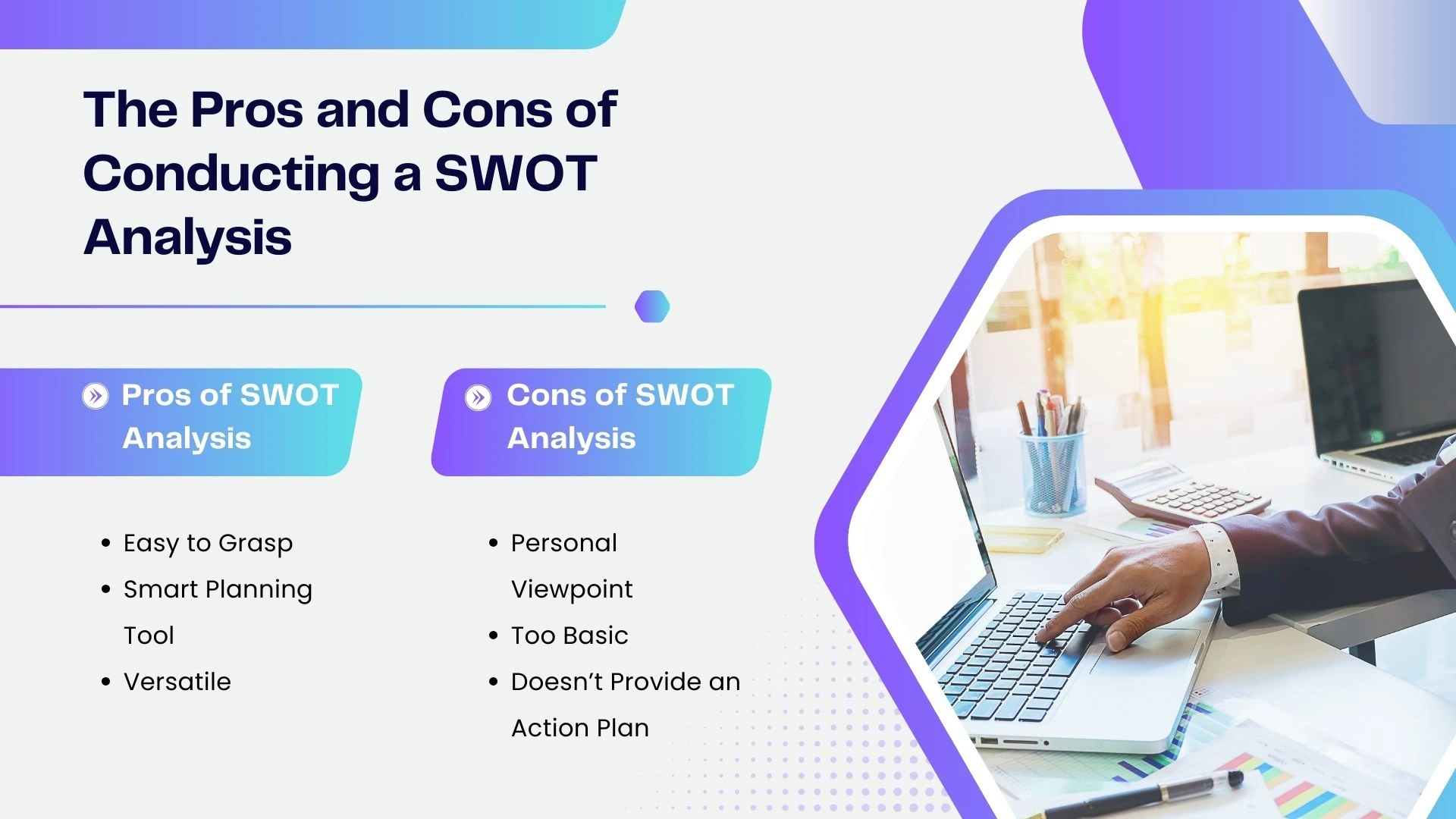SWOT Analysis – A Comprehensive Guide with a Realistic Example
- Sugathan
- December 26, 2024
Have you ever considered doing a SWOT analysis to understand your business better? SWOT analysis is a powerful tool that can help you gain insights into the overall posture of your business. It is not just useful for businesses but countless others like professionals, students, teams, NGOs, etc. If you are new to this concept and want to discover what it is, how it is done, what benefits it allows you to enjoy, a SWOT analysis example, etc., this blog will walk you through it.
What is SWOT Analysis?
SWOT analysis is a method to systematically assess a business, product, team, or even an individual. The word ‘SWOT’ is the abbreviation of Strengths, Weaknesses, Opportunities and Threats. Understandably, in a SWOT analysis, you will thoroughly evaluate each of these four areas to understand where the subject being evaluated stands.
Why Is SWOT Analysis Important?
SWOT analysis is a powerful strategy for one to understand their core competencies and identify areas that need improvement. It offers a comprehensive self-awareness in four important areas: strengths, weaknesses, opportunities, and threats. The findings from the evaluation can help prepare a long-term improvement strategy that can benefit in multiple ways, like adapting to changes, becoming more resilient to challenges, and capitalizing on the core strengths.
What Are the Components Of SWOT?
As you learn more about SWOT analysis through either reading or reviewing SWOT analysis examples, you will want to know more in detail about its components for a comprehensive understanding. So, let’s dissect each of the four components below.

Strength:
The first component in a SWOT analysis is understanding the strengths. In the case of a business, strengths would mean its competitive advantages in the market, such as brand reputation, loyal customers, etc.
Weakness:
Weaknesses are those factors that negatively affect a business’s performance. It could be its overreliance on outdated technology, poor company culture that drives away loyal employees, location disadvantages, etc. In a SWOT evaluation, these areas are inspected.
Opportunities:
Here, the focus is given to understanding a business’s untapped potential to grow and scale, such as a positive business trend that is emerging, a technology that the business can easily upgrade to for more productivity, etc.
Threats:
Along with understanding the potential to grow, it is also important to be well aware of any upcoming threats that are not directly visible now. For instance, the likelihood of changing customer preferences or an imminent economic downturn due to wars or calamities.
At What Stage and For What Reasons Is A SWOT Analysis Useful?
Studies show that SWOT analysis works best for businesses before they initiate any strategic planning or decisions. For instance, before launching a new product into the market or before entering into a business partnership.
SWOT analysis can be initiated for various reasons. To understand the strengths of your product so that you know how to further capitalize on it. Or to get a better picture of the challenges so you know how to overcome them effectively before they get intensified.
What Role Do Internal and External Factors Play in SWOT Analysis?
If you are figuring out how to conduct a SWOT analysis perfectly, you first need to get familiar with the factors forming its foundation. They are broadly categorized into internal and external factors.
Internal Factors:
By internal factors, what is being referred to are the strengths and weaknesses an organization has within it. They could be its resources, unique skills and processes, and even the workplace culture. The business has full control over these factors.
External Factors:
The last two letters of the word SWOT—O for Opportunities and T for Treats—are classified as external factors. They are not within the organization and thus beyond its control. For instance, market trends, competition, government regulations, advancements in technology, etc.
How To Do A SWOT Analysis?
Here is the step-by-step procedure on how to conduct a SWOT analysis.

Set a Clear Purpose
Pinpoint exactly what you want to understand or improve, whether it’s for a company, group, project, or yourself.
Find Your Strong Points (Strengths)
Do it by asking yourself
“What are we really good at?”
or
“What makes us stand out?”
Spot Your Weak Areas (Weaknesses)
Look closely at where you currently are and how you can get better by asking:
“What parts of our work need help?”
“What holds us back inside our organization?”
Discover Possible Opportunities
Look outside and find chances to grow by asking:
“Are there new trends we could use to sell more?”
“What good things might happen around us?”
Recognize Potential Threats
Look for things that could cause problems for your business by asking:
“Where are our rivals beating us?”
“What outside forces might hurt our plans?”
Pull It All Together
Make lists of everything you found and see how these different parts connect. Use these insights to create clear, practical steps that will help you succeed.
SWOT Analysis Example
Going through a SWOT analysis example is an excellent way to understand how this framework works in real-world scenarios. Here is an example of a SWOT analysis held at a logistics and shipping company.
-
SWOT Analysis for a Shipping and Delivery Business
-
Strengths
The company boasts of a strong connection network. They are using advanced technology for package tracking and have a skilled team. The brand reputation is strong and is known for dependable and quick deliveries. -
Weaknesses
Due to high fuel and vehicle maintenance expenses, the management finds running the business costs a lot. This has even affected them by limiting their coverage to a few areas and sometimes requiring dependence on outside partners. Some older equipment, which might slow down growth and make operations less smooth in certain regions, needs updating. -
Opportunities
The recent increase in online shopping trends appears positive for the brand as it is creating more need for shipping services, which the brand is specializing in. They can expand their services into new markets and use new technologies like artificial intelligence and automation systems to expedite services. -
Threats
There is tough competition from multinational shipping companies. Also, the changing rules and regulations and unpredictability of fuel prices could hurt the company's ability to scale realistically and expect a high turnover from the services. Inflation and economic drops are further influencing people’s frequency of using shipping services.
What Are the Main Pros and Cons of Conducting A SWOT Analysis?
While SWOT analysis is widely considered to be effective, it is important not to take it for granted as there are both pros and cons to it.

Pros of SWOT Analysis
- Easy to Grasp: SWOT analysis is simple to learn and use. With it, you have a clear and practical way to check how a business is doing right now.
- Smart Planning Tool: The SWOT framework helps you know what strong sides to use, weak areas to fix, chances to take, and risks to watch out for. It allows you to make smarter choices.
- Works Almost Anywhere: SWOT analysis can be used in different types of businesses. From tiny startups to big companies. It helps with both quick projects and long-term thinking.
Cons of SWOT Analysis
- Personal Viewpoint: The analysis depends a lot on what people think, which might lead to unfair or incomplete evaluations if not supported by solid facts and clear information.
- Too Basic: It might make complicated business problems look too simple, as it risks missing important details that could affect success or failure.
- Doesn’t give a real action plan: Without careful follow-up, a SWOT analysis could just create a list of points without clear, practical steps to improve weak spots or capitalize on new opportunities.
How Should Students Look for Expert Help with SWOT Analysis?
Unless done carefully and supported by careful background checks and market study, the outcome of a SWOT analysis can turn out to be a mere list of suggestions. Through our expert SWOT analysis assignment help, you can ensure getting detailed and practical output.
Conclusion
SWOT analysis is an extremely useful self-evaluation framework for both entities and individuals. The degree of accuracy of of the outcome you get from it, however, depends on when and how you do it.
We hope you found the insights on the SWOT analysis shared in this blog helpful. Do you have any questions regarding any concepts shared here? We look forward to hearing from you.
FAQ
In SWOT analysis, you will come across 3 Cs. They are: ‘Company,’ which refers to its internal capabilities; ‘Competitors,’ which may mean its market rivalries; and ‘Customers, which consists of consumer insights. Together, these three Cs provide a holistic overview of the business’s potential to grow.
A SWOT analysis example is nothing but the outcome or result of a SWOT analysis conducted for a particular company. For instance, imagine that company ‘A’ had a SWOT analysis done at the start of 2024. The result of the analysis could serve as a SWOT analysis example.

Mr. Sugathan is the founder of Professional Writing Services. He is an Army veteran who served the nation for more than two decades. During his tenure, he was involved in a lot of documentation and secretarial works. He has been drafting letters and documents on a daily basis.
Get In Touch
Related Services
- SOP Writing Services
- Linkedin Profile Writing Services
- Personal Statement Writing Services
- Website Content Writing Services
- Resume Writing Services
- SEO Copywriting Services
- Blog Writing Services
- Article Writing Services
- Motivation Letter Writing Services
- Personal Essay Writing Services
- Ad-copywriting Services
- Admission Essay Writing Services
- Cover Letter Writing Services
- eCommerce Content Writing Services
- Essay Writing Services
- Press Release Writing Services
- Case Study Writing Services
- Company Profile Writing Services
- Scholarship Essay Writing Services
- Landing Page Content Writing Services
- Letter Of Recommendation Writing Service
